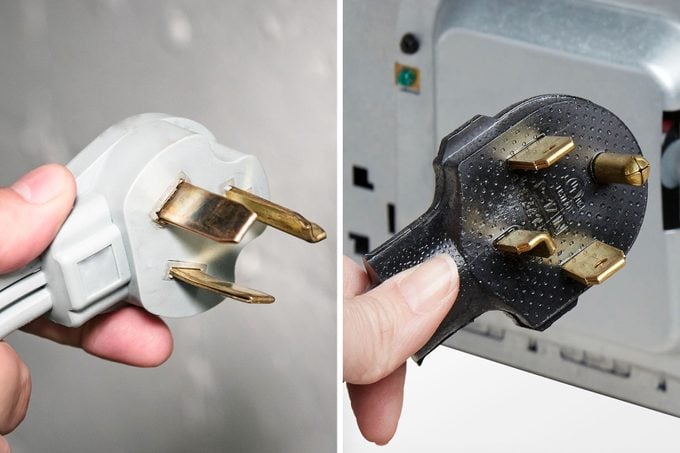Dryer Plug Types: 3-Prong vs. 4-Prong Dryers
Updated: Oct. 19, 2023
There's more than one way to plug in your dryer.
Our editors and experts handpick every product we feature. We may earn a commission from your purchases.

When you move, do you leave the appliances or take them? Dragging my old washer and dryer a thousand miles across the country wasn’t high on my list of enjoyable activities, so I left mine and started fresh. When the delivery guy dropped off the new dryer, the plug never entered my mind.
Well, it turns out, most new dryers don’t come with cords and plugs because there are two types: three-prong and four-prong. Which one you use depends on the wiring that’s installed at your dryer receptacle (aka outlet). I hadn’t even thought about that, and I’m an electrician!
Luckily, getting the right plug is easy. And you don’t have to modify your house wiring if you happen to have the “wrong” style — unless you really want to.
On This Page
Dryer Plug Types
First, let’s clarify. The three- and four-prong plugs we’re talking about here are for electric dryers.
Gas dryers also have three-prong plugs, but they’re the same 120-volt, 15-amp grounded plugs you have on your microwave, television and nearly every other appliance in your house. That’s because gas dryers only need enough juice to run the electronics. It’s the gas that supplies the heat.
Electric dryers, however, need a 240-volt, 30-amp circuit to run everything, including the heater that dries your clothes. The plugs are big and beefy and don’t look like regular plugs, which is a good thing. Because they deliver more electricity than normal, the configuration of the prongs is different so you can’t accidentally plug them in to the wrong receptacle.
Three-prong dryer plug
The three-prong plug was standard for electric dryers for decades and is still common in older homes. Electric dryers need two “hot” wires (and corresponding prongs) to deliver electricity from the main electrical panel to run the dryer, and one neutral, which is mainly used for the electronics.
Until the National Electric Code (NEC) updated dryer requirements in 1996, the neutral served double duty as the grounding means. Grounding appliances like dryers protect you from electric shock. (To learn more about how grounding works, check out our homeowner’s guide to electrical grounding.)
Four-prong dryer plug
A four-prong plug still has two hot and one neutral prong. But it also has a fourth specifically for grounding.
While this added safety feature reduces the risk of electric shock (in case something happens to the neutral connection inside the machine), the 1996 NEC update only applies to new construction or remodels. The NEC recognizes it’s not feasible for homeowners to update their electrical wiring every time they purchase a new dryer.
If you, like me, get a dryer delivered and find you only have a three-prong receptacle close by, it’s OK to use a three-prong plug instead of a four-prong, as long as you follow proper grounding procedures. These will be in your dryer manual, and I’ll explain them below.
Can I Use a Dryer Plug Adapter?
No. Never use an adapter to change a receptacle to fit your plug. This goes for any receptacle, not just the one for your dryer.
Plug prongs, once plugged in, are extensions of the wires going back to the electrical panel. Adapters change the number of holes available for your plug, but do nothing to the wires that actually carry the electricity. If you use an adapter to “make” your plug fit, you now have a useless extra prong that’s not performing the task it’s supposed to.
Adapters give a false sense of security, and they’re dangerous. Never use them.
How To Use or Upgrade a Dryer Plug
Depending on your home’s age and setup, you have the option of three- or four-prong plugs. Both are available at any home center or online, and the delivery person may even attach the plug for you.
Here are the options for a new dryer.
Use a three-prong plug
If you have an older home with a three-prong receptacle behind your washer and dryer hookup, it’s perfectly legal to use a three-prong plug. Follow the three-prong plug instructions that came with your dryer.
The dryer’s neutral (white) wire will be attached to the dryer frame. Leave it there, and attach the wires from the three-prong cord to the three screw terminals, as directed.
Use a four-prong plug
For newer homes, use a four-prong plug to fit your home’s receptacle.
In this scenario, you’ll remove the screw holding the neutral wire to the dryer frame, and combine that wire with the neutral wire from the cord under the center screw terminal. Attach the green wire from the cord to the dryer frame where you removed the neutral. The red and black wires go on the outside screws; it doesn’t matter which one goes on which screw.
Update your home’s wiring
If you have a three-prong receptacle behind your dryer but want to update your wiring to the latest NEC code standard, you must pull a new green wire, called an equipment grounding conductor, to the dryer from the panel.
Unless you have experience with electrical wiring, this may be best left to a qualified, licensed electrician. Once the wiring and receptacle are updated, follow the four-prong plug instructions that came with your dryer. Learn the most common reasons for that annoying dryer squeaking, and what you can do to make it stop.
